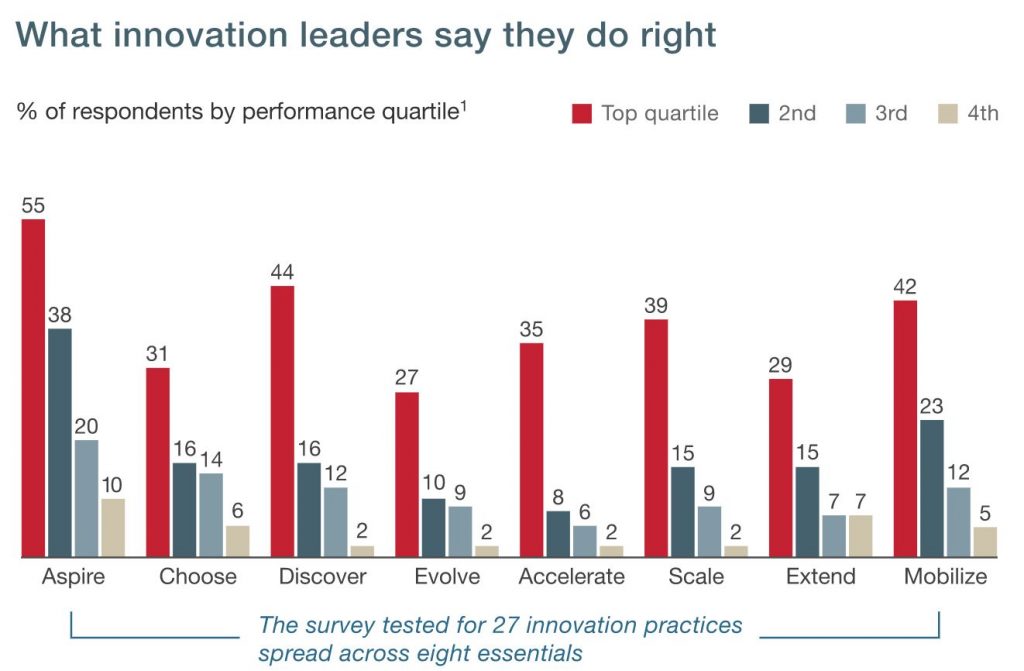You are here: Home / Leadership Insights / Leadership / Feeling stuck? Here are 4 strategies to boost business innovation

Feeling stuck? Here are 4 strategies to boost business innovation

Innovation culture it’s at the forefront of strategy for many Australian CEOs, but it’s also extremely difficult to achieve. Only 42.2% of Australian businesses report that they’re currently involved in innovative activities. Innovation is an incredibly abstract process. When aimless and unguided, innovation can be a waste of business resources. When too strict and contained, innovation hinders the development of any new thought.
Here are some strategies that you can use to boost your innovation culture while avoiding exhausting your resources.
1. Create a safe environment to experiment
When polled, 63% of employees cited a focus on operations as a barrier to innovation, while 52% cited a lack of resources and staff. When there isn’t time or energy to focus on innovation, it becomes impossible. And just as corporate-mandated fun never really seems to be fun, corporate-mandated creativity never really seems to be that creative.
The more you push for your employees to innovate, the more they may find it difficult: after all, there’s pressure to produce something from nothing. While innovation is important to a business, it can’t be forced or rushed because it can only thrive in a welcoming environment.
To create a safer environment, you need to welcome and indulge mistakes, and allow employees to explore and experiment with new ideas on their own time. Keep in mind that the most successful people in the world often had numerous failures before they hit upon the right idea: failure is a part of the process and that has to be emphasised.

Consider offering employees something similar to Google’s 20% time. Company-wide brainstorming sessions, similar to Hackathons, can give employees the time to focus on what will be beneficial to the business without being strictly guided. The worst you may get out of the process is a real insight into how your business works; if your brainstorming sessions don’t work, it will tell you something about your current business processes.
When employees are forced to innovate within a constrained, judgmental environment, they ultimately only give their managers what they believe their managers want to hear. They aren’t going to think outside of the box: instead, they’re going to focus on trying to deliver the ideas that they think are already desired. Furthermore, they’re not going to concern themselves with whether these ideas are truly new or functional. They’re just going to want to get any idea out of the door.
In Summary:
- To create a safe environment to experiment, give your employees the freedom to ideate and work on ideas in their own time.
- Conduct company-wide brainstorming sessions like Google’s 20% time to encourage a time to speak freely about current business processes that may or may not be working.
2. Qualitatively and quantitatively integrate innovation into your business
Has your business truly bought into innovation culture or is it just going through the motions?
Innovation has to be baked into your business: a good leader will need to regard innovation as critical if they’re going to see results. If you aren’t prioritising innovation throughout your business processes, it’s going to be a second thought, and it’s not going to be effective.
But how do you create a business that puts innovation first? According to McKinsey, ‘It helps to combine high-level aspirations with estimates of the value that innovation should generate to meet financial-growth objectives.’ In other words, you need to make it clear that innovation is a part of your strategic growth and future plans. It must be clear at all levels of the organisation that innovation is important and it must be clear that innovation, in and of itself, is a target.

That means that innovation isn’t only rewarded if it’s successful: innovation itself becomes a metric of success. Managers won’t just focus on the bottom line: they will focus on fostering the process of innovation and will regard active innovation as a pursuit to be chased.
While this may seem a little counterproductive, it’s critical because innovation is so abstract. As mentioned, innovation can’t occur in a pressure cooker: this is an easy way to burn out and to foster ideas that don’t really click. Instead, innovation has to be fostered gently and encouraged to grow, and the only way it can do so is through lending innovation inherent, intractable value.
In Summary:
- Make sure everyone understands that innovation is the goal of the company and integrate innovation and strategic growth as a priority.
- Foster an innovative and creative environment
3. Encourage critical thinking
To truly innovate, a company cannot just ask itself the expected questions; it has to be willing to ask itself completely unexpected ones. If an employee is able to increase the efficiency of a product by 10%, leaders should ask if they can improve efficiency by 20%. If an employee is able to increase the battery power of a device, a strong leader won’t just ask if it can be more efficient – they will ask if it even needs a battery.
The goal of this isn’t to force someone to come up with an unreasonable or impossible product or service, but rather to trust in the development process. Following up on these questions and using critical thinking may lead to different innovations all together. Brainstorming involves thinking about the impossible and considering whether you may be able to do things completely differently.
There are many things that businesses are doing today that were once thought to be impossible.
Progress is a matter of always reaching a little farther than someone initially expected, you can better achieve the products of ‘five years from now’ by targeting the products of ‘ten years from now.’ By pushing forwards to a constantly moving target, you can prepare yourself better for the future.
In Summary:
- To truly innovate, companies need to learn how to think outside the box and welcome questions that encourage critical thinking
- Challenge the impossible and set targets that encourage your employees to think about the future and new ways to do things differently
4. Look externally before looking in
Rather than trying to motivate your staff to innovate purely internally, look outside to see what else is going on. Cultivate external relationships with other companies and people who are doing similar things; it’s possible that the answer to your innovation dilemma is already out there. Often creating a ‘brain trust’ and pulling in consultants is exactly the type of synergy a company needs to begin to grow.
Industry events showcasing best-in-class and new ideas and technology can be inspirational to employees who want to grow and develop, as can interfacing with other employees in their space.
Sending your top talent to speak with others and investigate new solutions helps both you and them. It shows that you not only care about innovation but also your team’s personal and creative growth. Watch The Vistage Group Experience here.
Vistage’s peer advisory groups connect Australian and New Zealand business leaders together, allowing them to share learnings and expert advice.
Operating in a vacuum is often a substantial problem with a company. You may find that you’re already reinventing the wheel, chasing a problem that has already been solved, or attacking a problem from the incorrect direction. Many employees find themselves more inspired by others and improving upon these connections also fosters relationships for your business.
In Summary:
- Establish partnerships with other companies and businesses that are also targeting innovation
- Creating a brain trust through external consultants help challenge your way of thinking and can push you forward towards growth
- Encourage your teams to attend industry showcases and tech innovation conferences to foster their own personal and creative growth
Driving business innovation through better leadership
Ultimately, the best way for businesses to foster its innovation culture is through its leadership.
Australian CEOs need to foster a more open and innovative culture with its employees and develop better relationships with them in the process.
Employees thrive in an open and supportive work environment that allows them to explore and ideate.
And when your teams find innovation exciting and rewarding, they will be more likely to engage.
Employees who aren’t afraid of failure come up with better ideas and will be more willing to take risks that fuel innovation. Strong leadership can push organisations forward by fostering an environment that is results-driven yet fully supportive of their internal teams to dream larger.
By connecting employees with the outside world, fostering their independence, and showing them how innovation can help them, Australian CEOs can drive their employees towards ever loftier goals.
A company without innovation is going to fall behind the competition. But as you can see, fostering innovation requires strategy, leadership, and interpersonal skills. Vistage can help you connect with leaders and entrepreneurs throughout the globe, so you can learn new ways to bring ideas into fruition while inspiring and motivating your teams. To learn more, connect with us today



